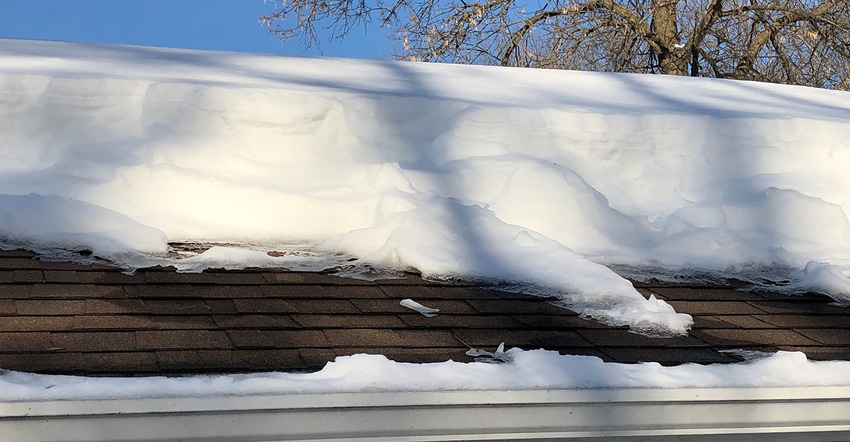
After heavy snowfall in late February across Minnesota, 20 barn roofs collapsed due to excessive snow and ice.
Unfortunately, winter is not over yet and, realistically, we should plan on getting more of the white stuff.
According to University of Minnesota Extension information provided by agricultural engineer Kevin Janni, the snow load for residential building roofs in the state is set by state statutes: 42 pounds per square foot in northern Minnesota and 35 psf in southern Minnesota. Many agricultural buildings have been built using a 20 psf snow load. Accordingly, Janni notes, those roofs would be expected to handle six feet of dry, fluffy snow or one foot of wet, heavy snow.
Janni explains that trying to estimate the weight of snow and ice on a roof is difficult because snow density can range from three pounds per cubic foot for light, fluffy snow to 21 pcf for wet, heavy snow. Ice density is around 57 pcf.
Farmers could get an estimate snow load on a roof by collecting and weighing one cubic foot of snow on the ground by a shed or barn, he says. Then estimate or measure snow depth on the roof. If your cubic foot of snow weighs 11 pounds and you have 2 feet of snow on the roof, then you have about 22 psf of snow load on your roof.
First, though, you should know the snow load capacity of your barn or shed, which is determined by the truss capabilities, Janni says. Building suppliers, contractors and truss manufacturers should have provided this information. In most cases, agricultural buildings will have an excessive snow load if there are more than 4 to 6 feet of snow on the roof, he says.
Before you remove snow from roofs, check for building damage or failure. Look at the walls for buckling and at knee braces and trusses for failure or damage.
Remove snow by shoveling or raking. Depending on the depth and roof condition, you might need to call in professional help.
Ready for snowmelt
After this winter’s heavy snow, Minnesotans are looking ahead and wondering where the snowmelt will go and how it could impact their homes and businesses. On the farm, snowmelt will challenge operations this spring by flooding buildings, feed and bedding storage in low areas, livestock and barnyards, and in-ground manure storage pits and basin.
Plus, refreezing will make flooded lanes and roads dangerously slippery for animals, people and equipment.
Janni suggests the following before spring snowmelt begins:
Remove deep snow. Plow or scrape snow off to the side of outdoor exercise lots, feeding areas and heavy traffic lanes. Avoid pushing uphill of outdoor lots, feeding areas and traffic lanes so snowmelt won’t drain through those areas. Also avoid removing manure or wasted feed with the snow unless it will be land applied properly to cropland.
Pile snow strategically. Carefully consider where you place snow when you move it around the farm. Locate piles so snowmelt will drain away from animal lots or traffic lanes rather than through them.
Check covers on manure storage pits and basins. Properly fit pump-out covers on deep manure pits so snow and roof runoff do not drain into the pit.
Manage roof runoff. This one might be more challenging if water runs off barn roofs and into animal lots. A shallow trench or ditch beneath the overhang can help direct this water out of the yard. Better yet, Janni suggests installing gutters and downspouts in the future that empty away from the animal lot. Also, grade the ground around farm buildings to slope away from the building.
Go online to learn more about what you can do to prevent future snowmelt problems.
You can also learn more on managing snow loads on barn and shed roofs.
About the Author(s)
You May Also Like






